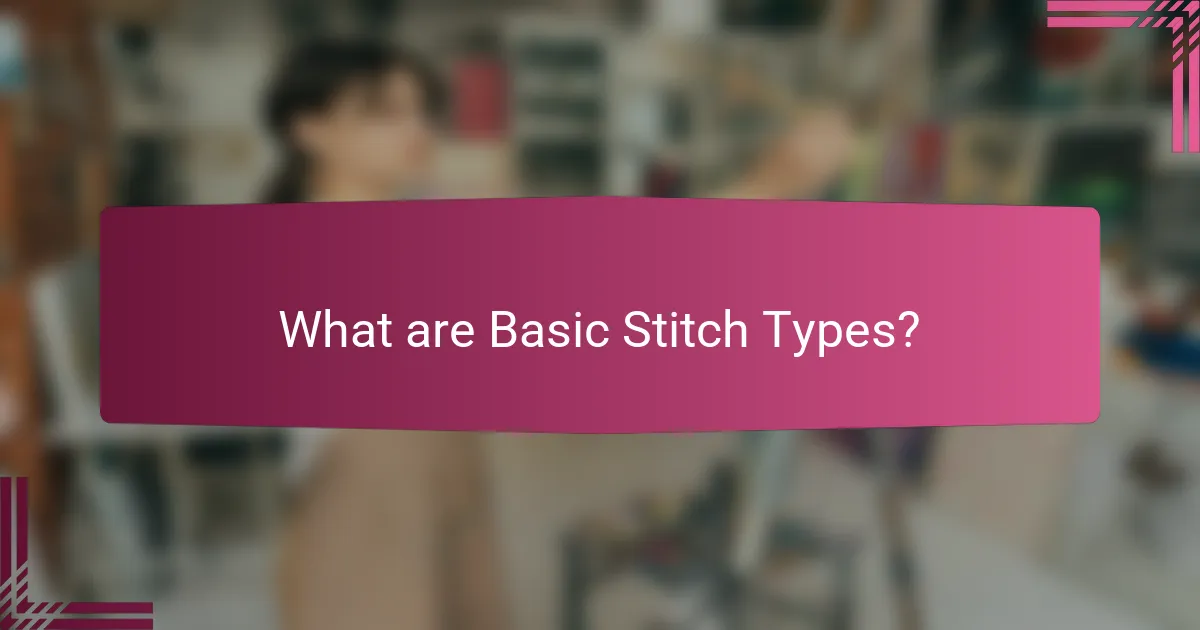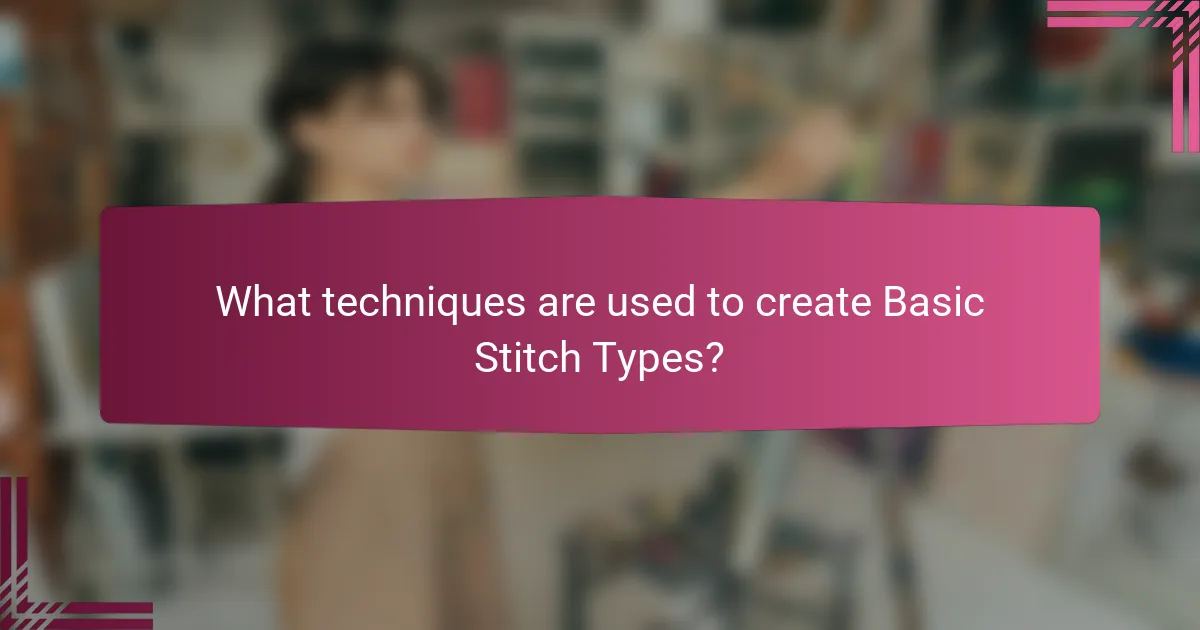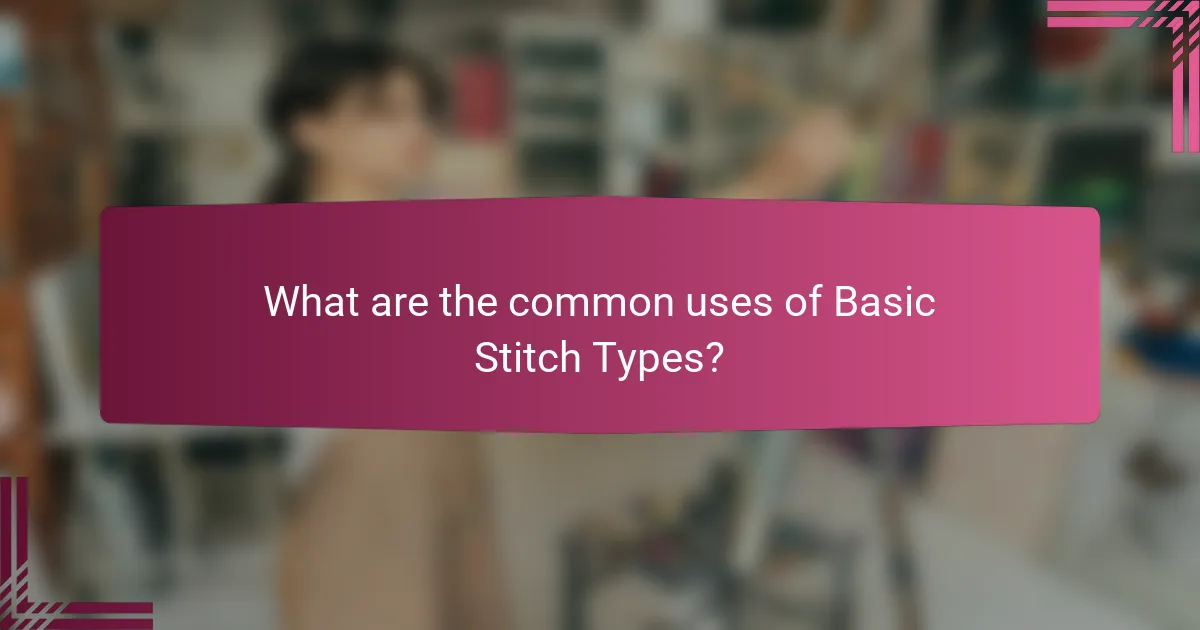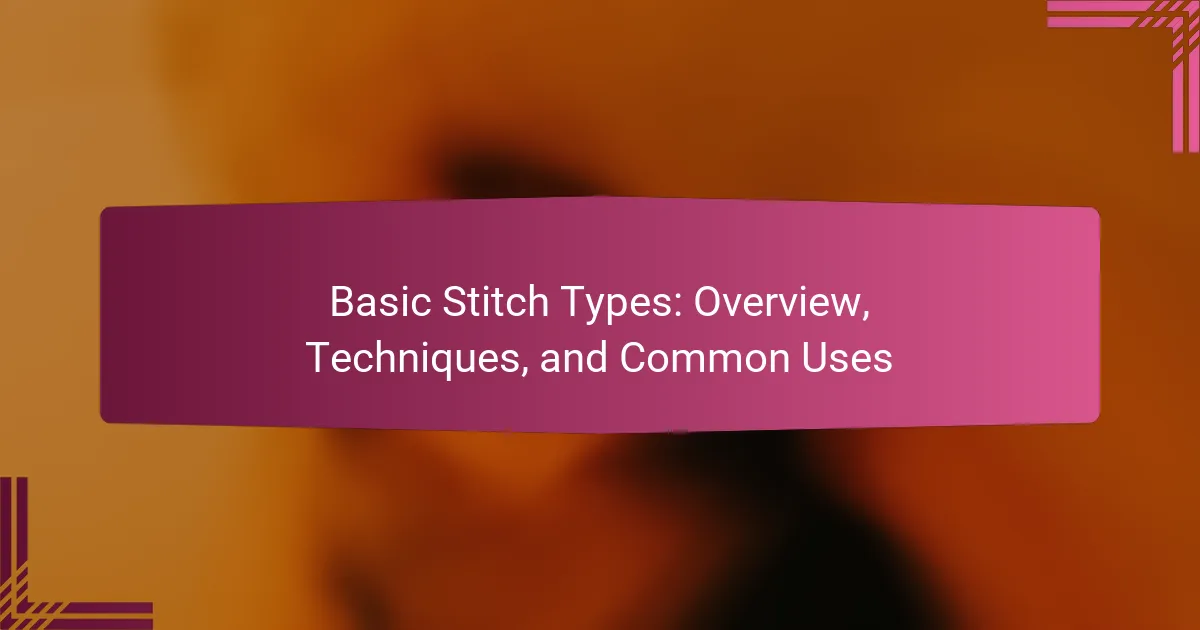
What are Basic Stitch Types?
Basic stitch types are fundamental sewing techniques used in various fabric projects. They include straight stitch, zigzag stitch, and backstitch. The straight stitch is the most common, providing a simple line of stitching. Zigzag stitch allows for flexibility and stretch in fabrics. Backstitch creates a strong seam by sewing backward and forward. Each stitch type serves specific purposes in garment construction and repair. For instance, straight stitch is often used for seams, while zigzag stitch is ideal for finishing edges. Understanding these basic stitch types enhances sewing skills and project outcomes.
How are Basic Stitch Types categorized?
Basic stitch types are categorized based on their function and technique. The primary categories include straight stitches, zigzag stitches, and decorative stitches. Straight stitches are used for basic seams and hems. Zigzag stitches allow for stretch and flexibility in fabrics. Decorative stitches serve aesthetic purposes and enhance the visual appeal of the fabric. Each category serves distinct purposes in sewing and crafting. These classifications help in selecting the appropriate stitch for specific projects.
What are the primary categories of Basic Stitch Types?
The primary categories of basic stitch types are hand stitches, machine stitches, and decorative stitches. Hand stitches include basic techniques like the running stitch and backstitch. Machine stitches are created using a sewing machine, such as straight stitches and zigzag stitches. Decorative stitches add embellishment to fabric, including techniques like satin stitch and appliqué. Each category serves distinct functions in sewing and crafting. Hand stitches are often used for repairs and delicate work. Machine stitches are preferred for efficiency and speed in garment construction. Decorative stitches enhance the visual appeal of finished projects.
How do different categories serve various purposes?
Different categories of stitch types serve various purposes in sewing and crafting. Each stitch type is designed for specific functions. For example, straight stitches are commonly used for seams. Zigzag stitches provide stretch and prevent fraying. Decorative stitches enhance the visual appeal of a project. Quilting stitches secure layers of fabric together. Hemming stitches finish the edges of garments. Each category addresses unique needs in textile applications. Understanding these distinctions helps in selecting the appropriate stitch for a given task.
Why are Basic Stitch Types important in crafting?
Basic stitch types are important in crafting because they form the foundation of various techniques. Mastery of basic stitches enables crafters to create complex designs. Each stitch type serves a specific purpose, such as joining pieces or adding texture. For example, the straight stitch is fundamental for sewing seams. The zigzag stitch prevents fabric fraying and adds flexibility. Knowledge of these stitches enhances creativity and versatility in projects. Furthermore, basic stitches are often the first skills taught in sewing and knitting classes. This foundational knowledge is crucial for both beginners and advanced crafters alike.
How do Basic Stitch Types enhance the quality of projects?
Basic stitch types enhance the quality of projects by providing structural integrity and aesthetic appeal. Different stitch types serve various functions, such as securing fabric layers or adding decorative elements. For instance, straight stitches create a strong hold, while zigzag stitches allow for stretch in knit fabrics. The choice of stitch type can affect the durability of the finished product. Quality stitches contribute to a professional appearance in sewing projects. Techniques like backstitching reinforce seams, preventing unraveling. Furthermore, using appropriate stitch types reduces fabric puckering and enhances overall finish. Mastery of basic stitch types is essential for achieving high-quality results in sewing.
What role do Basic Stitch Types play in different crafting techniques?
Basic stitch types are fundamental components in various crafting techniques. They serve as the building blocks for creating patterns and textures. Different crafting methods, such as knitting, crocheting, and embroidery, utilize these basic stitches to achieve specific effects. For example, the knit stitch creates a smooth fabric in knitting, while the chain stitch forms the foundation in crocheting. Each basic stitch type contributes to the overall design and functionality of the crafted item. Mastery of these stitches allows crafters to explore more complex techniques and designs. This foundational knowledge is essential for both beginners and experienced artisans.

What techniques are used to create Basic Stitch Types?
Basic stitch types are created using various techniques. Common techniques include the straight stitch, zigzag stitch, and backstitch. The straight stitch is made by sewing in a straight line, typically used for seams. The zigzag stitch involves sewing in a zigzag pattern, allowing for stretch in fabrics. The backstitch is created by sewing backwards, providing strong seams. Each technique serves specific purposes in sewing projects. For example, the straight stitch is foundational for most garments. The zigzag stitch is essential for knit fabrics to prevent fraying. The backstitch is often used for repairs and reinforcing seams. These techniques form the basis of sewing skills and applications.
How do you execute common Basic Stitch Techniques?
To execute common Basic Stitch Techniques, start by selecting the appropriate stitch type for your project. For a straight stitch, position the fabric under the needle and lower the presser foot. Set the machine to a straight stitch setting and begin sewing at a consistent speed. For a zigzag stitch, adjust the stitch width and length settings accordingly. Place the fabric under the presser foot and sew, ensuring the fabric moves smoothly. To execute a backstitch, sew forward a few stitches, then reverse for the same number of stitches to secure the seam. Each technique requires proper tension and fabric alignment for optimal results. Following these steps will yield clean and professional-looking stitches.
What tools are necessary for creating Basic Stitch Types?
To create basic stitch types, essential tools include a needle, thread, and fabric. The needle is used to pierce the fabric and carry the thread through it. Various needle sizes accommodate different fabric types. The thread must match the fabric in weight and color for optimal results. A pair of scissors is necessary for cutting the thread and fabric. Additionally, a measuring tape helps ensure accurate fabric dimensions. Pins or clips can hold fabric pieces together while stitching. Lastly, a sewing machine may be used for quicker and more consistent stitches. Each tool plays a crucial role in achieving precise stitching outcomes.
What are the step-by-step processes for popular Basic Stitch Types?
The step-by-step processes for popular basic stitch types include the following:
1. **Straight Stitch**: Start by threading the needle and securing the fabric. Lower the presser foot. Guide the fabric under the needle. Press the foot pedal to sew a straight line. Stop and lift the needle to finish.
2. **Zigzag Stitch**: Thread the machine and select the zigzag stitch setting. Place the fabric under the presser foot. Adjust the stitch width and length as needed. Begin sewing while guiding the fabric. Stop and lift the needle to complete.
3. **Backstitch**: Position the fabric and thread the needle. Begin sewing forward for a few stitches. Reverse the direction to sew backwards over the same stitches. Continue forward sewing for a secure seam. Finish by lifting the needle.
4. **Basting Stitch**: Thread the machine and select a long stitch length. Position the fabric under the presser foot. Sew along the desired line without backstitching. Repeat for additional basting lines. Remove the stitches later as needed.
5. **Slip Stitch**: Fold the hem or fabric edge. Thread a needle with matching thread. Insert the needle through the folded edge. Catch a small amount of the main fabric. Continue this process along the hem, ensuring stitches are hidden.
These processes are essential for various sewing projects and are commonly used in garment construction and repairs.
What challenges might arise when using Basic Stitch Techniques?
Challenges that might arise when using Basic Stitch Techniques include difficulty in achieving consistent tension. Inconsistent tension can lead to uneven stitches, affecting the overall appearance of the project. Another challenge is limited versatility; basic stitches may not be suitable for complex designs. This limitation can hinder creativity and the ability to execute intricate patterns. Additionally, beginners may struggle with mastering the techniques. This struggle can result in frustration and decreased motivation to continue learning. Lastly, there is a risk of physical strain. Repetitive motions can lead to discomfort or injury over time.
How can beginners overcome difficulties with Basic Stitch Types?
Beginners can overcome difficulties with Basic Stitch Types by practicing regularly and seeking guidance. Consistent practice helps build muscle memory and improves technique. Utilizing instructional videos can provide visual demonstrations of each stitch type. Joining a community or group can offer support and advice from experienced stitchers. Using high-contrast yarn and needles can enhance visibility and ease of handling. Breaking down each stitch into smaller steps simplifies the learning process. Additionally, keeping a stitch journal can track progress and identify areas for improvement.
What common mistakes should crafters avoid?
Crafters should avoid several common mistakes to improve their projects. One mistake is not reading patterns thoroughly before starting. This can lead to misunderstandings and errors in execution. Another mistake is using the wrong materials or tools. Each project requires specific supplies for optimal results. Additionally, crafters often skip the gauge swatch. This can result in incorrect sizing and fit. Not taking breaks can lead to fatigue and mistakes. Crafters should also avoid rushing through projects. Taking time ensures quality and attention to detail. Lastly, neglecting to clean up workspaces can lead to lost materials and increased frustration.

What are the common uses of Basic Stitch Types?
Basic stitch types are commonly used in sewing and embroidery. They serve various purposes including construction, decoration, and finishing. Straight stitches are primarily used for seams. Zigzag stitches are often used to prevent fabric fraying. Backstitch is utilized for strong seams in hand sewing. Decorative stitches enhance the visual appeal of projects. Basting stitches temporarily hold layers of fabric together. Hemming stitches finish edges for a clean look. Each stitch type has specific applications based on fabric and project requirements.
How do Basic Stitch Types apply to different crafting projects?
Basic stitch types are essential in various crafting projects. For knitting, the garter stitch provides elasticity and texture, making it ideal for scarves. In crochet, the single crochet stitch creates a dense fabric suitable for amigurumi. The slip stitch is often used for joining pieces in both knitting and crochet, ensuring a seamless finish. The chain stitch serves as the foundation in crochet, allowing for versatile designs. Each stitch type contributes unique properties, enhancing the functionality and aesthetic of the final project. Understanding these applications allows crafters to choose the right stitch for their specific needs.
What types of projects commonly utilize Basic Stitch Types?
Basic Stitch Types are commonly utilized in various sewing projects. These projects include garment construction, home decor items, and quilting. Basic stitches are essential for creating seams in clothing. They are also used for hems and finishing edges. In home decor, basic stitches are found in pillowcases and curtains. Quilting projects often employ basic stitches for piecing fabric together. Crafts like embroidery also incorporate basic stitch types for decorative purposes. These applications highlight the versatility and fundamental nature of basic stitch types in sewing.
How do Basic Stitch Types influence the final appearance of a project?
Basic stitch types significantly influence the final appearance of a project. Each stitch type contributes unique texture and visual effects. For instance, a straight stitch creates a clean and simple look. In contrast, a zigzag stitch adds elasticity and decorative flair. The choice of stitch type can also affect the fabric’s drape and structure. Certain stitches, like the satin stitch, provide a glossy finish, enhancing the overall aesthetic. Additionally, the spacing and tension of stitches impact the project’s uniformity and neatness. Therefore, understanding basic stitch types is essential for achieving desired visual outcomes in textile projects.
What tips can enhance the use of Basic Stitch Types?
To enhance the use of basic stitch types, practice consistency in tension. Maintaining even tension results in uniform stitches. Use proper tools, such as appropriate needles and threads for the fabric type. This ensures smoother stitching and better results. Familiarize yourself with different stitch patterns and their applications. Understanding when to use each stitch type can improve your projects. Experiment with variations in stitch length and width. This can add texture and interest to your work. Lastly, always keep a sample swatch for reference. This helps track progress and maintain quality throughout your project.
How can you choose the right Basic Stitch Type for your project?
To choose the right Basic Stitch Type for your project, first identify the fabric type you will use. Different fabrics require different stitch types for optimal results. For instance, lightweight fabrics benefit from a straight stitch, while knits require a zigzag stitch for stretch. Next, consider the purpose of your project. Decorative projects may need specialty stitches, while functional items require strong, durable stitches. Additionally, evaluate the thread type and needle size. The right combination enhances stitch quality and project durability. Lastly, consult sewing guides for specific recommendations based on your project type. These guides often provide insights into the best stitch types for various applications.
What are best practices for mastering Basic Stitch Techniques?
Practice consistently to master basic stitch techniques. Regular practice reinforces muscle memory and improves precision. Start with simple stitches like the straight stitch and zigzag stitch. Gradually progress to more complex techniques as confidence builds. Use high-quality materials to enhance the stitching experience. Proper lighting and ergonomic positioning reduce strain and improve focus. Follow instructional videos or guides for visual learning. Joining a sewing group can provide support and feedback. These practices are supported by sewing experts who emphasize the importance of repetition and community engagement in skill development.
Basic stitch types are fundamental sewing techniques essential for various fabric projects, including straight stitch, zigzag stitch, and backstitch. The article categorizes these stitches based on their functions and techniques, highlighting their importance in garment construction, decoration, and finishing. It covers the tools required for creating these stitches, step-by-step processes for executing them, and common challenges faced by beginners. Additionally, the article emphasizes best practices for mastering these techniques and their influence on the final appearance of crafted items. Understanding basic stitch types enhances sewing skills and project quality across multiple crafting disciplines.
